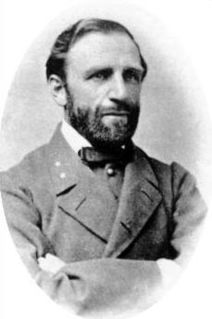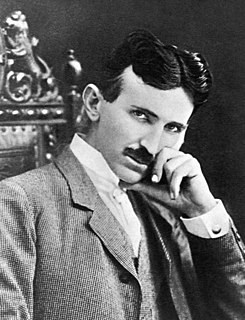
The Illinois Central Railroad, sometimes called the Main Line of Mid-America, was a railroad in the central United States, with its primary routes connecting Chicago, Illinois, with New Orleans, Louisiana, and Mobile, Alabama. A line also connected Chicago with Sioux City, Iowa (1870). There was a significant branch to Omaha, Nebraska (1899), west of Fort Dodge, Iowa, and another branch reaching Sioux Falls, South Dakota (1877), starting from Cherokee, Iowa. The Sioux Falls branch has been abandoned in its entirety.

The Louisville and Nashville Railroad, commonly called the L&N, was a Class I railroad that operated freight and passenger services in the southeast United States.

William Ward Duffield was an executive in the coal industry, a railroad construction engineer, and an officer in the Union Army during the American Civil War. After the war he was appointed Superintendent of the U.S. Coast and Geodetic Survey.
The Cincinnati, New Orleans and Texas Pacific Railway is a railroad that runs from Cincinnati, Ohio, south to Chattanooga, Tennessee, forming part of the Norfolk Southern Railway system.

The American Civil War was the first in which large armies depended heavily on railroads to bring supplies. For the Confederate States Army, the system was fragile and was designed for short hauls of cotton to the nearest river or ocean port. During the war, new parts were hard to obtain, and the system deteriorated from overuse, lack of maintenance, and systematic destruction by Union raiders.

Williams Carter Wickham was a Virginia lawyer, plantation owner and politician. At the Virginia Secession Convention of 1861, Wickham voted against secession, yet when fellow delegates and voters approved secession, he became an important Confederate cavalry general. After the American Civil War, Wickham became a Republican and served in the Virginia Senate as well as became President of the Chesapeake and Ohio Railway company.

Basil Wilson Duke was a Confederate general officer during the American Civil War. His most noted service in the war was as second-in-command for his brother-in-law John Hunt Morgan; Duke would later write a popular account of Morgan's most famous raid: 1863's Morgan's Raid. He took over Morgan's command after Morgan was shot by Union soldiers in 1864. At the end of the war, Duke was among Confederate President Jefferson Davis's bodyguards after his flight from Richmond, Virginia, through the Carolinas.

Pontchartrain Rail-Road was the first railway in New Orleans, Louisiana. Chartered in 1830, the railroad began carrying people and goods between the Mississippi River front and Lake Pontchartrain on 23 April 1831. It closed more than 100 years later.

The Texas and New Orleans Railroad was a railroad in Texas and Louisiana. It operated 3,713 miles (5,975 km) of railroad in 1934; by 1961, 3,385 miles (5,448 km) remained when it merged with parent company Southern Pacific.

Louisville in the American Civil War was a major stronghold of Union forces, which kept Kentucky firmly in the Union. It was the center of planning, supplies, recruiting and transportation for numerous campaigns, especially in the Western Theater. By the end of the war, Louisville had not been attacked once, although skirmishes and battles, including the battles of Perryville and Corydon, took place nearby.

The Confederate Heartland Offensive, also known as the Kentucky Campaign, was an American Civil War campaign conducted by the Confederate States Army in Tennessee and Kentucky where Generals Braxton Bragg and Edmund Kirby Smith tried to draw neutral Kentucky into the Confederacy by outflanking Union troops under Major General Don Carlos Buell. Though they scored some successes, notably a tactical win at Perryville, they soon retreated, leaving Kentucky primarily under Union control for the rest of the war.
Thomas Armstrong Morris was an American railroad executive and civil engineer from Kentucky and a soldier, serving as a brigadier general of the Indiana Militia in service to the Union during the early months of the American Civil War. During the Western Virginia Campaign in 1861, he played an important role in leading regiments from West Virginia, Indiana and Ohio in clearing the Confederate army from western Virginia during the Battle of Philippi, a move that helped bolster pro-Union sentiment and contributed to the creation of the separate state of West Virginia. Morris was also instrumental in the planning and construction of the postbellum Indiana State House.

The Historic Railpark and Train Museum, formerly the Louisville and Nashville Railroad Station in Bowling Green, Kentucky, is located in the historic railroad station. The building was placed on the National Register of Historic Places on December 18, 1979. Opened in 1925, the standing depot is the third Louisville & Nashville Railroad depot that served Bowling Green.
The Winchester and Potomac Railroad (W&P) was a railroad in the southern United States, which ran from Winchester, Virginia to Harpers Ferry, West Virginia, on the Potomac River, at a junction with the Baltimore and Ohio Railroad (B&O). It played a key role in early train raids of the B&O during the beginning months of the American Civil War.

Benjamin Franklin Terry raised and commanded the 8th Texas Cavalry Regiment, popularly known as Terry's Texas Rangers, during the American Civil War. A planter and prominent citizen of Fort Bend County, he organized the regiment for the Confederate States Army. Terry was killed in the regiment's first action at Rowlett's Station near Woodsonville, Kentucky.
The Houston and Texas Central Railway (H&TC), a predecessor of today's Union Pacific Railroad, was an 872-mile railway system chartered in Texas in 1848, with construction beginning in 1856. The line eventually stretched from Houston northward to Dallas and Denison, Texas. with branches to Austin and Waco.

Isaac Munroe St. John was a Confederate States Army brigadier general during the American Civil War. He was a lawyer, newspaper editor and civil engineer before the Civil War and a civil engineer after the Civil War. As a civil engineer, he worked for the Baltimore and Ohio Railroad Company and the Blue Ridge Railroad Company in South Carolina before the Civil War. After the war, he worked for the Louisville, Cincinnati and Lexington Railroad in Kentucky; the city of Louisville, Kentucky; and the Chesapeake and Ohio Railway Company.
John A. Haydon was a prominent American surveyor and civil engineer. As a self-taught civil engineer, Haydon made significant contributions to American railroading. Haydon's railroad career spanned the Baltimore and Ohio railroad expansion to the Ohio river in 1853 and several other railroads to the last transcontinental railroad, the Northern Pacific railway. Haydon led the 1872 Yellowstone River expedition, where he faced a Sioux Indian skirmish led by Sitting Bull, Red Cloud and Crazy Horse at the Battle of Pryor's Creek, Montana. He also served as a captain in the Confederate Army Corps of Engineers under Generals Tilghman and Beauregard; captured at the battle of Fort Henry, early in the Civil War in 1862, he was paroled at Aiken, South Carolina, in November 1862 to serve the rest of the war, including the Richmond–Petersburg Campaign. In the latter part of his life, he worked locating branch railroads such as the Pennsylvania railroad in Maryland and for the Western Maryland railroad.



















